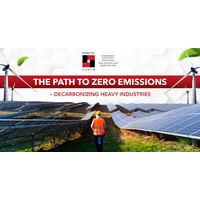
Heavy industries are the backbone of modern economies, but they also have a hefty carbon footprint. Due to their high energy demands and process-related emissions, industries such as steel, cement, and chemicals account for over half of industrial energy use and around 70% of direct CO2 emissions.
As the world races towards net-zero targets, innovative cleantech solutions are emerging as beacons of hope. This blog will explore the cleantech solutions paving the way for the decarbonization of heavy-duty industries. We will also delve into the challenges these sectors face, the technologies driving change, and the policies supporting this transition.
What is stopping us from full decarbonization?
There are two major challenges to transitioning to fully green energy sources:
Economic Challenges
Renewable energy sources require a large infrastructure, which can be expensive upfront. They also take up considerable real estate, and their storage and maintenance costs ultimately go through the roof. Presently, non-renewable sources are being stored and transferred on a large scale, and the same solution for wind and solar energy is not feasible yet. As per the International Renewable Energy Agency (IRENA), building a net-zero emissions pathway by 2050 requires an investment of almost $4 trillion in the global energy sector by 2030.
Scalability Issues
Clean energies such as wind and solar energy are good for a limited amount of use, but they cannot match the requirements of heavy industries. While few homes can run on some kilowatts of energy daily, large-scale machinery and electricity may need tons of energy, which wind and solar cannot promise.
Green Energy Sources – The Keys To Full Decarbonization
Continued research and development on cleantech have revealed four key alternatives to fossil fuels, which are also suitable for heavy industries:
Green methanol – The Simplest Solution For Current Requirements
A viable solution to our energy sources must be something that replaces them. Transforming engines globally is a very arduous initiative. Green methanol fills this void as it can be used in existing engines with some modifications. It has high energy density, so it can replace gasoline and diesel and meet marine and aviation requirements. It is also easy to store, and more than 100 Mn tonnes per year of green methanol are transported globally. From a business perspective, the green methanol market size is worth $39 Bn, with shipping and planes being the main drivers.
Green Ammonia – The Zero-Carbon Fuel For The Future
Ammonia (NH3) is the top candidate as a green hydrogen carrier for the energy market. It is a liquid fuel at moderate pressure with high-energy density, similar to green methanol. However, engines suitable for green ammonia are still being developed. Green NH3 is also easy to store, transport, and distribute, and its handling and safety standards are already in place. With applications in fertilizers, refrigerants, and pharmaceuticals, the market value of ammonia itself is $84 Bn. Its identity as a marine fuel alternative and hydrogen carrier is a huge market driver.
Hydrogen-based Technologies
Clean hydrogen manufactured with renewable energy can decarbonize steel, cement, and chemical industries. Furthermore, hydrogen can support the integration of several renewables in the electricity system and facilitate storing energy for days, weeks, or months. The green hydrogen market was valued at almost $1.1 Bn in 2023 and is projected to reach $30.6 Bn by 2030, indicating promising growth over the next several years.
Energy Management Systems
An energy management system (EnMS) is a framework for tracking and managing energy use by industrial, commercial, or public sector organizations. The system helps in identifying instances where companies can save energy and reduce their carbon footprint. Implementing EnMS can lead to a 20% reduction in energy consumption costs, which is why it is widely used in manufacturing and industrial sectors. The increasing demand for energy efficiency and sustainability are key market drivers for EnMS, leading to a valuation of $52.7 Bn in 2023, with a projected growth rate of 14.5% in the coming ten years.
State Of Energy Transition: Policies and Investments
Decarbonizing heavy industries such as steel, cement, and chemicals is a critical component of the global effort to combat climate change. The Paris Agreement of 2015 aims to limit global warming to well below 2 degrees Celsius and requires countries to set targets for reducing greenhouse gas emissions. The European Union’s Fit for 55 Package is an ambitious set of policies that aims to reduce the EU’s net greenhouse gas emissions by at least 55%.
Significant investments are being made to support this transition, driven by both public and private sectors. In 2023, global investment in the energy transition reached a record $1.8 trillion, marking a 17% increase from the previous year. This investment encompasses various sectors, including renewable energy, electrified transport, hydrogen, carbon capture and storage (CCS), and energy storage. China remains the largest market for energy transition investment, contributing $676 billion in 2023, which is 38% of the global total. Next is the United States, with over $300 billion in 2024, driven by policies like the Inflation Reduction Act (IRA).
Famous personalities are also leading the charge for the use of clean energy and transition. Bill Gates has been a significant advocate for clean energy transition through his work with CemVision and other initiatives. CemVision is a cement startup that offers a viable alternative to traditional cement by recycling industrial waste to create a sustainable form of cement. Elon Musk is driving innovation in electric vehicles and renewable energy through Tesla, Solar City, and other ventures. In fact, Tesla's Master Plan 3 outlines a vision for a sustainable energy economy, estimating it would cost $10 trillion but save $4 trillion compared to continuing with fossil fuels. Jeff Bezos’ Amazon has become the largest corporate buyer of renewable energy globally, with 206 renewable energy projects worldwide. The company aims to power 100% of its activities with renewable energy by 2025, five years ahead of its original target. The Bezos Earth Fund has pledged $10 billion in grants to organizations fighting climate change.
The collective effort of large-scale companies and government intervention signal a change in the right direction. With continued sustainable practices and reduced dependence on carbon-based energy sources, the future looks hopeful for a greener earth.
References:
https://www.iea.org/reports/net-zero-by-2050
https://www.sciencedirect.com/science/article/pii/S0360544220311324#sec4
https://www.marketsandmarkets.com/Market-Reports/green-hydrogen-market-92444177.html
https://www.airproducts.com/energy-transition/can-hydrogen-power-heavy-industry-with-zero-emissions
https://www.iea.org/energy-system/low-emission-fuels/hydrogen


